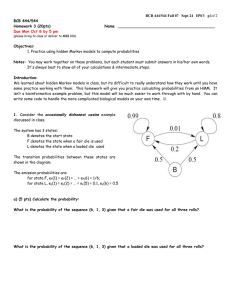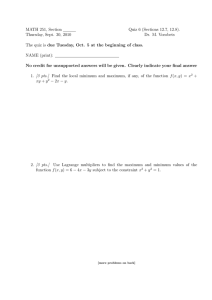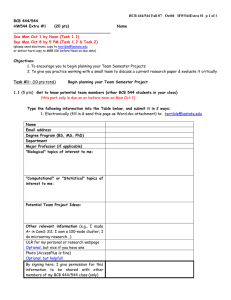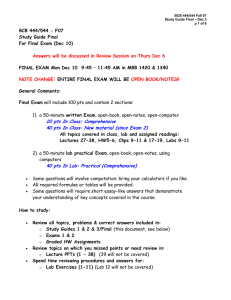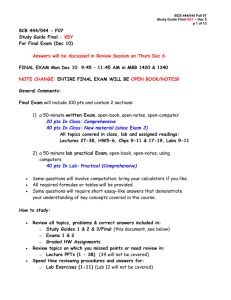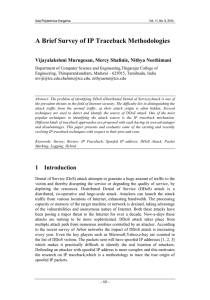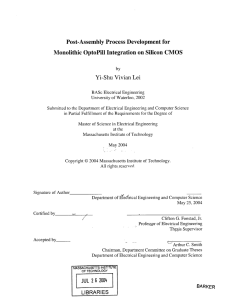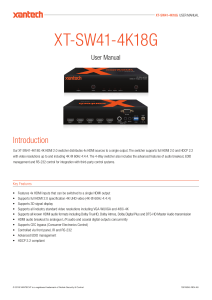BCB 444/544 Fall 07 Sept 24 ... BCB 444/544 Homework 3 (20pts)
advertisement
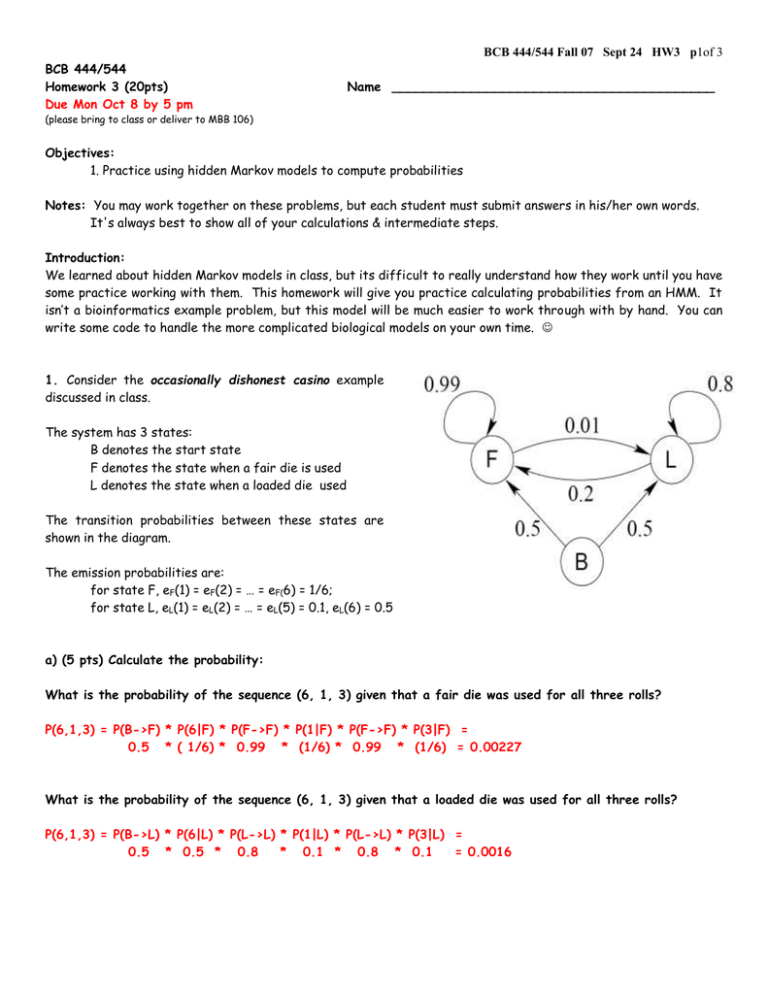
BCB 444/544 Fall 07 Sept 24 HW3 p1of 3
BCB 444/544
Homework 3 (20pts)
Due Mon Oct 8 by 5 pm
Name _________________________________________
(please bring to class or deliver to MBB 106)
Objectives:
1. Practice using hidden Markov models to compute probabilities
Notes: You may work together on these problems, but each student must submit answers in his/her own words.
It's always best to show all of your calculations & intermediate steps.
Introduction:
We learned about hidden Markov models in class, but its difficult to really understand how they work until you have
some practice working with them. This homework will give you practice calculating probabilities from an HMM. It
isn’t a bioinformatics example problem, but this model will be much easier to work through with by hand. You can
write some code to handle the more complicated biological models on your own time.
1. Consider the occasionally dishonest casino example
discussed in class.
The system has 3 states:
B denotes the start state
F denotes the state when a fair die is used
L denotes the state when a loaded die used
The transition probabilities between these states are
shown in the diagram.
The emission probabilities are:
for state F, eF(1) = eF(2) = … = eF(6) = 1/6;
for state L, eL(1) = eL(2) = … = eL(5) = 0.1, eL(6) = 0.5
a) (5 pts) Calculate the probability:
What is the probability of the sequence (6, 1, 3) given that a fair die was used for all three rolls?
P(6,1,3) = P(B->F) * P(6|F) * P(F->F) * P(1|F) * P(F->F) * P(3|F) =
0.5 * ( 1/6) * 0.99 * (1/6) * 0.99 * (1/6) = 0.00227
What is the probability of the sequence (6, 1, 3) given that a loaded die was used for all three rolls?
P(6,1,3) = P(B->L) * P(6|L) * P(L->L) * P(1|L) * P(L->L) * P(3|L) =
0.5 * 0.5 * 0.8
* 0.1 * 0.8 * 0.1
= 0.0016
BCB 444/544 Fall 07 Sept 24 HW3 p2of 3
b) (10 pts) Finding the most likely path:
What is the most probable sequence of states, starting from state B, to produce the sequence of die tosses
(6, 1, 3)? Show your work.
The sequence of states is B->F->F->F.
B
F
L
6
1
3
1
0
0
0
0
= 1/6 * max
{1 * 0.5,
0,
0}
= 1/6 * 0.5 = 1/12
= 1/6 * max
{0,
1/12 * 0.99,
0.25 * 0.2}
= 1/6 * 1/12 * 0.99
= 0.01375
= 1/6 * max
{0,
0.01375 * 0.99,
0.02 * 0.2}
= 1/6 * 0.01375 * 0.99
= 0.00227
0
= 1/2 * max
{1 * 0.5,
0,
0}
= 1/2 * 0.5 = 1/4
= 0.1 * max
{0,
1/12 * 0.01,
0.25 * 0.8}
= 0.1 * 0.25 * 0.8
= 0.02
= 0.1 * max
{0,
0.01375 * 0.01,
0.02 * 0.8}
= 0.1 * 0.02 * 0.8
= 0.0016
PLEASE NOTE that traceback is NOT necessarily from lower right corner to upper left (per DP) with Viterbi
(this was a mistake in Xiong textbook!) Traceback begins in cell with highest probability in the last column,
which corresponds to the last die in the sequence. Because of this error and confusion associated with it, we
did not deduct points for starting at 0.0016, as long as traceback was otherwise correct.
BCB 444/544 Fall 07 Sept 24 HW3 p3of 3
c) (5 pts) Finding the total probability of an observed sequence:
What is the total probability of the sequence (6, 1, 3)? Show your work.
B
F
L
6
1
3
1
0
0
0
0
= 1/6 * sum
{1 * 0.5,
0,
0}
= 1/6 * 0.5 = 1/12
= 1/6 * sum
{0,
1/12 * 0.99,
0.25 * 0.2}
= 1/6 * (0.0825 + 0.05)
= 0.022083
= 1/6 * sum
{0,
0.022083 * 0.99,
0.020083 * 0.2}
= 1/6 * (0.02186217 + 0.0040166)
= 0.004313
0
= 1/2 * sum
{1*0.5,
0,
0}
= 1/2 * 0.5 = 1/4
= 0.1 * sum
{0,
1/12 * 0.01,
0.25 * 0.8}
= 0.1 * (0.00083 + 0.2)
= 0.020083
= 0.1 * sum
{0,
0.022083 * 0.01,
0.0020083 * 0.8}
= 0.1 * (0.00022083 + 0.0160664)
= 0.001629
The total probability is 0 + 0.004313 + 0.001629 = 0.0059417
